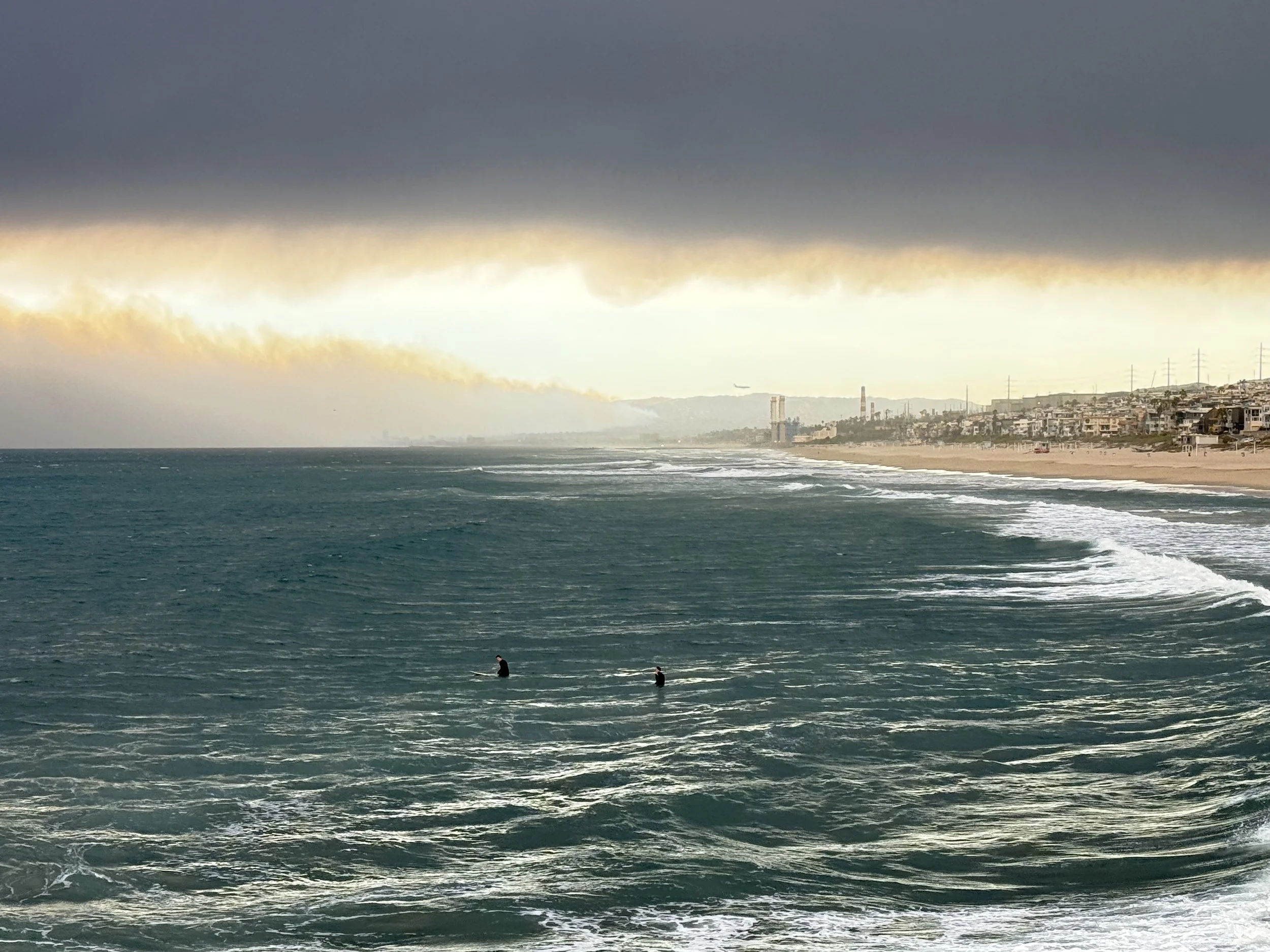What’s happening in Los Angeles, the city I have lived in since late 1992, the city I love, is nothing less than a monumental disaster. The fires will prove a defining event in the 21st century history of Los Angeles and California.
But to suggest, as some would do, that the Summer Games of 2028 are not going to happen here because of the fires – that’s just stupid. Indeed, LA28 now has a narrative – a phoenix, if you will, from the ashes.
Any such suggestion belies even a basic understanding of the geography of Los Angeles and, more broadly, of Southern California; of the layout of the 2028 Olympic venues, and of the way a Games in the United States gets financed.
From the Manhattan Beach pier, looking north — no filter — last Wednesday at the Palisades fire some 20 kilometers away. The dark cloud is smoke and ash
It also ignores the real existential danger to LA28: The Big Earthquake. We have not had a major quake since January 1994.
A suggestion that these fires have changed things for 2028 is fear talking. Fear is not how Los Angeles and California work. The history here is that life is on the edge, always. It’s what makes it great and sometimes, like now, makes us confront the hard reality of geography: we choose to live in a desert by an ocean ringed by mountains.
If you want flat and boring and normal, go to Des Moines. Des Moines is not the next host of the Summer Olympics. Indeed, people from Des Moines come to Los Angeles to chase their dreams.
Even though Los Angeles has burned before and will burn again.
In 1961, Bel Air burned. A famous photo shows Richard Nixon, the former vice president and future president, dressed in a shirt and tie, watering a rooftop with a garden hose at a rented house on North Bundy Drive.
Afterward, the Los Angeles Fire Department produced a documentary, “Design for Disaster,” narrated by William Conrad. It called the densely packed homes nestled on hillsides covered in dry brush "a serious problem in fire protection, even under the best of conditions."
From the history books — the Bel Air fire in 1961, including Richard Nixon on a rooftop with a garden hose
In 1978, six years before the 1984 Olympics that changed everything, 11 fires in four Southern California counties destroyed more than 200 homes, killed three people and hurt at least 50. From the LA Fire Department historical archive:
“With or without sufficient and sophisticated resources and backbreaking effort, Southern California is ultimately at the mercy of weather, fate and firebugs – a big, fragile, arterial oasis in a natural desert.”
The 1993 Old Topanga Fire burned across Malibu for 10 days. It would kill three people, destroy 359 homes and burn 18,000 acres.
What is it about the Olympics that sparks (word used intentionally) such fear? In the next couple years, the World Cup and the Super Bowl are coming here, too. No one remotely is suggesting they ought to be canceled. But the Olympics? Why catastrophize?
In November 2023, fire erupted under a portion of what we call the 10, meaning Interstate 10, the Santa Monica Freeway, just east of downtown Los Angeles, a roadway that sees 300,000 vehicles daily. The fire caused major damage to the 10. Initial estimates were that it would take three to five weeks to fix. It got done in eight days.
The fires are still not out in the Palisades, a bedroom community in the northwestern corner of Los Angeles. Role in the Olympics? Zero. Altadena, just north of Pasadena, site of the Eaton fire, is likewise a suburb. Role in the Games? None.
Santa Monica is just south of the Palisades. It is not on fire. Across the 405 freeway to the east is UCLA. That’s where the athletes’ village will be. It is not on fire.
Farther south of Santa Monica lies LAX. To its east, under the flight path, sits SoFi Stadium and the new LA Clippers arena, both in urban Inglewood. They are not on fire. Neither is the Coliseum, across the street from USC near downtown Los Angeles, nor the Rose Bowl, in Pasadena. The venues in Carson are south, way down the 405 from the fires. Similarly, the venues in Long Beach? Down from where the 710 freeway dead-ends near-ish Pasadena, also a long way away.
The only Olympic venue at risk? That would be Riviera Country Club, proposed site of the 2028 golf tournament.
Worst-case scenario: golf is played in 2028 at Torrey Pines in San Diego or Pebble Beach up in northern California, or somewhere.
Meantime, let’s everyone remember that in the United States an organizing committee is privately financed. So, no government money needs to be – or possibly would be- re-allocated to make the $6.9 billion LA28 budget.
Again and again and again: the city would be responsible for the first $270 million of any organizing committee cost overrun but the odds of this organizing committee not making its budget are – absent The Big Earthquake or some other apocalypse – next to zero.
Prediction: the organizing committee will register a surplus. Probably a significant one.
Will the city likely be paying overtime in 2028 to firefighters and police officers? Yes. Has this been foreseeable for a long time? Yes. Before this week’s fires? Yes.
My wife and I live about 20 kilometers from the Palisades, in a beach town south of LAX. We are, so far, fine, and appreciate the kind words from those who have reached out.
That said, we know many, many who have lost their homes, and of course this is the heart-wrenching story of the fires. It’s also the reason why the Games can, should and will be held in Los Angeles in 2028.
It has been said before at this website and will be repeated here now:
Life demands two things most of all, water and hope. At their core, the Olympics is about hope.
In the Palisades, a good friend who has been around the Olympic scene since 1984 lost his home. Same over in Altadena: an LA Times reporter colleague from back in the day lost his house. Same story back in the Palisades, now the sister of the newly elected district attorney – the DA and I have known each other for nearly 30 years.
The Forward reports that while the Kehillat Israel synagogue in the Palisades is still standing (even as the Presbyterian church two buildings over “was flattened”), all three rabbis lost their homes and so did 300 families. My wife and I know one of those families well.
Just, please, one more story, because – after having been part of life in Southern California amid riots, earthquakes, prior fires and so much more – it says so, so much about Los Angeles, and the centrality of hope and goodwill in our world, fragile and broken and, sometimes, burned:
In the Palisades, as the LA Times reported, St. Matthew’s parish school and church says at least 75% of its members lost their homes. The school was destroyed. The church suffered “serious damage.”
“God’s will has nothing to do with this fire,” Los Angeles Episcopal Bishop John Taylor told the paper.
“God’s will is urgently desiring that people come together and devote themselves to each other’s healing.”



